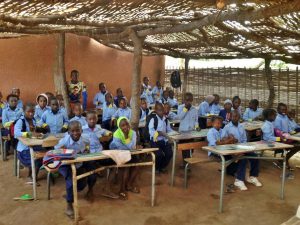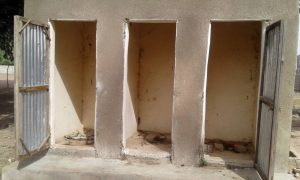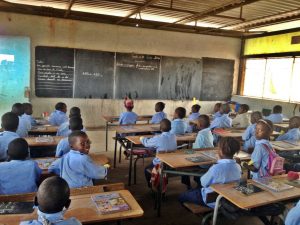This project is made possible through the partnership of WATER CHARITY and the NATIONAL PEACE CORPS ASSOCIATION. ![]()
 Location
Location
Medina Yoro Foulah and Niaming, Kolda, Senegal
Community Description
Two communes in the Kolda region of Senegal are included in this project. The first consists of nine villages with an estimated total population of 3,100 inhabitants; the second consists of 45 villages with an estimated total population of 150,000 inhabitants.
These populations are very young: almost 50% of the population is under the age of 18. The main ethnic groups are Fulakunda, Pula-Foutah, Wolof, and Serrer.
It takes approximately 3 hours by car to travel from these communes to the regional capital, along an unpaved dirt road that can sometimes become impassible during the rainy season of July through October.
Agriculture and animal husbandry compose the bulk of economic activity in the two communes. Almost all adults, as well as many children and teenagers, are involved in some kind of agricultural or gardening activity, either for sale at the weekly Sunday market or for personal consumption. People primarily plant and harvest millet, corn, peanuts, mangoes, bananas, eggplants, okra, and chili peppers. Other vegetables such as tomatoes and carrots are consumed within the community as well, but they are usually imported from other areas.
Both communes are located in the poorest region of the country, with the majority of the population living below the poverty line of $1.90 per day according to the World Bank. This is evident in every aspect of life: people cannot always afford food, clothing, medication or other basic necessities. Two examples can be found in education and health: a large number of students cannot afford tuition for middle or high school; and many people cannot pay the 200-300 CFA (roughly 35 US cents) to see the doctor when they suspect they (or their children) have malaria.
 Problem Addressed
Problem Addressed
Between them, the communes support two pre-schools, 15 elementary schools, one middle school, and one high school. The extreme poverty of the two communes has meant that, as of now, only nine of these schools (all at the elementary level) have been able to afford to provide their students with functioning latrines. Two other schools have latrines, but they are in a state of such complete disrepair that they cannot be used by the students. The rest of the schools have no latrines at all.
The children in these communities relieve themselves in the bush and do not wash their hands, a hygiene problem that can negatively impact both the children and their communities. Diarrhea and other illnesses related to a lack of hygiene are common.
Beyond general hygiene problems, the lack of functional latrines exacerbates gender imbalances, particularly at the higher levels of schooling. Teen girls who have reached puberty often choose to stay home during their period for lack of adequate hygiene resources. For example, in one of the communes, the ratio of boys to girls in school drops from 50/50 in primary school to 70/30 in high school. Furthermore, some classes at the high school level have no female students at all.
Project Description
The project targets schools in a number of rural villages in the Medina Yoro Foulah district of the Kolda region of Senegal. The plan is to rehabilitate 13 latrines in the village of Medina Yoro Foulah (four at the pre-school and nine at the elementary school), and to construct 16 new latrines in the following locations: four each in Sare Demba and Sinthiang Yoro Douda, and three each in Touba Mboyene, Sinthiang Sadio, Demanoufa, and Kour Sally.
The Peace Corps Volunteers in the two communes plan to address these issues through the rehabilitation of the existing latrines, the construction of new latrines where none existed previously, the implementation of joint hand washing/soap making classes for students and their parents, and the introduction of additional activities aimed specifically at girls to encourage them to stay in school (i.e. Girls’ Club, sports/nutrition class, mentoring and tutoring).
 The Peace Corps Volunteers will be responsible for purchasing and ensuring the delivery of most necessary project materials to the site of the repairs. The community will be responsible for quarrying and transporting the necessary quantities of sand and gravel. Water for construction is available on site (through faucets), it will also be provided by the community.
The Peace Corps Volunteers will be responsible for purchasing and ensuring the delivery of most necessary project materials to the site of the repairs. The community will be responsible for quarrying and transporting the necessary quantities of sand and gravel. Water for construction is available on site (through faucets), it will also be provided by the community.
Over the course of the repairs, the Peace Corps Volunteers and the Mayor will be responsible for overseeing the work on a daily basis and for dealing with any problems that arise.
More specifically, the rehabilitation of the 13 existing latrines, under the supervision of one mason and one plumber, will cover the following:
1. Elementary school (eight student latrines, one teacher latrine)
a. The pipes connecting the latrine cabins with the pit are broken. These need to be replaced.
b. The PCV pipes providing aeration have snapped off; these also need to be replaced.
c. The doors and their hinges are damaged beyond repair and need to be replaced.
d. There is currently no privacy wall in front of the latrines. This needs to be built to conform to cultural norms to allow female students to use the latrines.
e. The cement cover of the pit is cracked and needs to be re-done.
f. There is currently no running water available for students to wash their hands. A new line must be connected to the school water mainframe and faucets must be established next to the latrines.
g. The latrine holes and pipes (within the cabins) are broken. They will be replaced with Turkish seats for easier use by the students. The eight student cabins will also be tiled (as requested by the principal), to facilitate easier cleaning and maintenance through the students.
h. The teacher latrine has no roof and no door.
i. There are four latrines on the school premises that are beyond repair (the pits have caved in and the cabin bricks are disintegrating). They are a serious health hazard and need to be removed.
2. Pre-school (four toilets within one bathroom)
a. The cement cover of the latrine pit has fallen into the pit and must be re-done.
b. The toilets are all clogged and need to be un-clogged.
c. None of the four English toilets currently have seats. The students, therefore, cannot use the toilets, as they would fall in.
d. The toilet boxes for three of the toilets are broken and need to be replaced.
e. There is currently no running water available for students to wash their hands. The existing faucets in the bathroom will be connected to the pre-school’s water mainframe.
A second mason will be responsible for the construction of the 16 new latrines at the other schools. In each of the six villages, the village in question will appoint an assistant mason to ensure that the communities are fairly represented and involved. Two of the villages will receive four toilets each (one each for male and female students, and one each for male and female teachers and other staff). The other four villages will receive two toilets each (one each for male and female students).
Again, all materials necessary for construction (other than gravel and sand) will be bought and transported to a central drop-off location by the Peace Corps Volunteers. All of these materials, in addition to gravel and sand (which will be quarried and transported to individual villages by community members), will be transported by the villages, as will be water, in whatever quantities necessary.
The construction of the new latrines will cover the following: 1. Pit
a. The latrine pit will be 2m x 2m x 2m in size and will be lined with cement bricks to maintain structural integrity. The pit will be dug by the community and will be lined by the mason.
b. The latrine cover will be made of cement and rebar and will be constructed by the mason.
c. A PVC pipe extending from the pit will permit aeration.
2. Latrine Cabin
a. The latrine cabins, sized at 1m wide x 1.5m deep x 2m tall, will be built apart from the pit; waste will move from the latrine cabins to the pit via a PVC pipe. This construction ensures the longevity of the latrine: the mayors of the respective communes have agreed to incorporate money into their yearly budgets to have the pits emptied when they become full. The latrines will be built in pairs and will share one wall to reduce the materials needed for construction.
b. The latrines will be tiled to facilitate cleaning.
c. Each school will have either two or four latrines to separate for boys and girls.
d. For all new latrines, privacy walls will be built to ensure the latrines conform to cultural norms, allowing female students to use the latrines.
e. The doors of the new latrines, like those on the repaired latrines, will be made of iron. This is to ensure the durability and longevity of the latrines.
Transportation of required materials from the central drop-off point to the final village location is also the responsibility of the community members. Donkey- and horse-drawn carts will be arranged to move the materials from the central drop-off point to the individual schools.
All involved parties (masons, plumber, school principals, school security guards, mayors, Peace Corps Volunteers) have agreed to share responsibility on monitoring construction materials, keeping an inventory, signing out materials, and storing it in one central and lockable location until such time as it will be used.
Rehabilitation of the existing latrines and construction of the new latrines will start at the same time, at the beginning of February 2017. The second mason and the Peace Corps Volunteers will determine the order of villages for the construction of the new latrines.
The project is backed and supported by the communities. The communities and the Peace Corps Volunteers collaborated to decide on the design, layout, and exact location of the latrines. The design was chosen in discussions between the mason, plumber, respective school principals, and Peace Corps Volunteers.
The general layout of the latrines is based on the wishes of the mayors, as they have agreed to be responsible for latrine upkeep: the latrines will be separated from the pits so trucks can periodically remove waste when the pits are full. This serves to increase the longevity of the latrines. On a day-to-day basis, general cleaning and maintenance of the latrines will be undertaken by the teachers and students at each benefiting school.
The location of the latrines on school grounds was determined during meetings with the village chiefs, principals, and presidents of the parent-teacher associations in each village.
Also, in each village, a meeting was held to decide on in-kind and labor contributions. All the communities have offered to quarry and transport the sand and gravel necessary for the construction and rehabilitation of the latrines. The remaining community contribution will be paid in cash by the mayors for their respective communes.
Project Impact
The project will immediately benefit 1,000 students (currently enrolled), 32 teachers, and 500 parents
Peace Corps Volunteer Directing Project
Laura d’Elsa and Abigail Pershing
Monitoring and Maintenance
The Peace Corps Volunteers will be responsible for the following:
– Supervising/monitoring construction/rehabilitation of 13 existing and 16 new latrines
– Conducting joint soap-making / handwashing classes at all eight schools with students and parents
– Purchasing construction materials, creating an inventory list, and monitoring material use
– Tutoring / mentoring female students at all eight schools
The mayors of the two communes will be responsible for:
– Paying the 10% cash contribution
– Coordinating delivery of the 15% in-kind contribution
– Supervising/monitoring construction/rehabilitation of 13 existing and 16 new latrines
– Maintaining latrines after their rehabilitation/construction, including emptying pits and repairing them when they are broken
The masons and plumber will be responsible for building/repairing the latrines.
The eight schools (principals, teachers, students) will be responsible for:
– Inviting participants for the joint soap-making / handwashing classes
– Attending classes
– Cleaning new latrines on a regular basis
Let Girls Learn
This project is part of the Let Girls Learn program started by FLOTUS Michelle Obama in partnership with the Peace Corps. The goal of this project is to keep girls attending to school. It is a part of Water Charity’s Let Girls Learn Initiative – Worldwide.
The lack of functional latrines in these eight schools exacerbates gender imbalances. It is currently almost impossible for girls on their periods to engage in good hygiene practices while at school, especially given the total lack of functional latrines at the secondary level.
During the 2015/2016 school year, 531 students attended one of the primary schools, of whom 266 were boys and 265 were girls; that same year, 177 students attended the high school, of whom 125 were boys but only 52 were girls. This huge drop in the percentage of girls attending school is in part due to the inaccessibility of latrines. By repairing the latrines at the secondary education level, this barrier to girls’ education will be drastically reduced.
In addition, the Peace Corps Volunteers’ commitment to introducing additional activities aimed specifically at girls to encourage them to stay in school (including mentoring and the formation of Girls’ Clubs) will help address the gender imbalance issues in education.
Fundraising Target
$6,400
Funds raised in excess of the project amount will be allocated to other projects in the country.
Donations Collected to Date
$1,629
ADOPT THIS PROJECT BY CONTRIBUTING THE DOLLAR AMOUNT OF THE PROJECT.
Donations of any amount will be appreciated. The full amount will give you “naming rights”, if that is something you would like.
Dollar Amount Needed
$4,771
This project has been completed. To read about the conclusion, CLICK HERE.